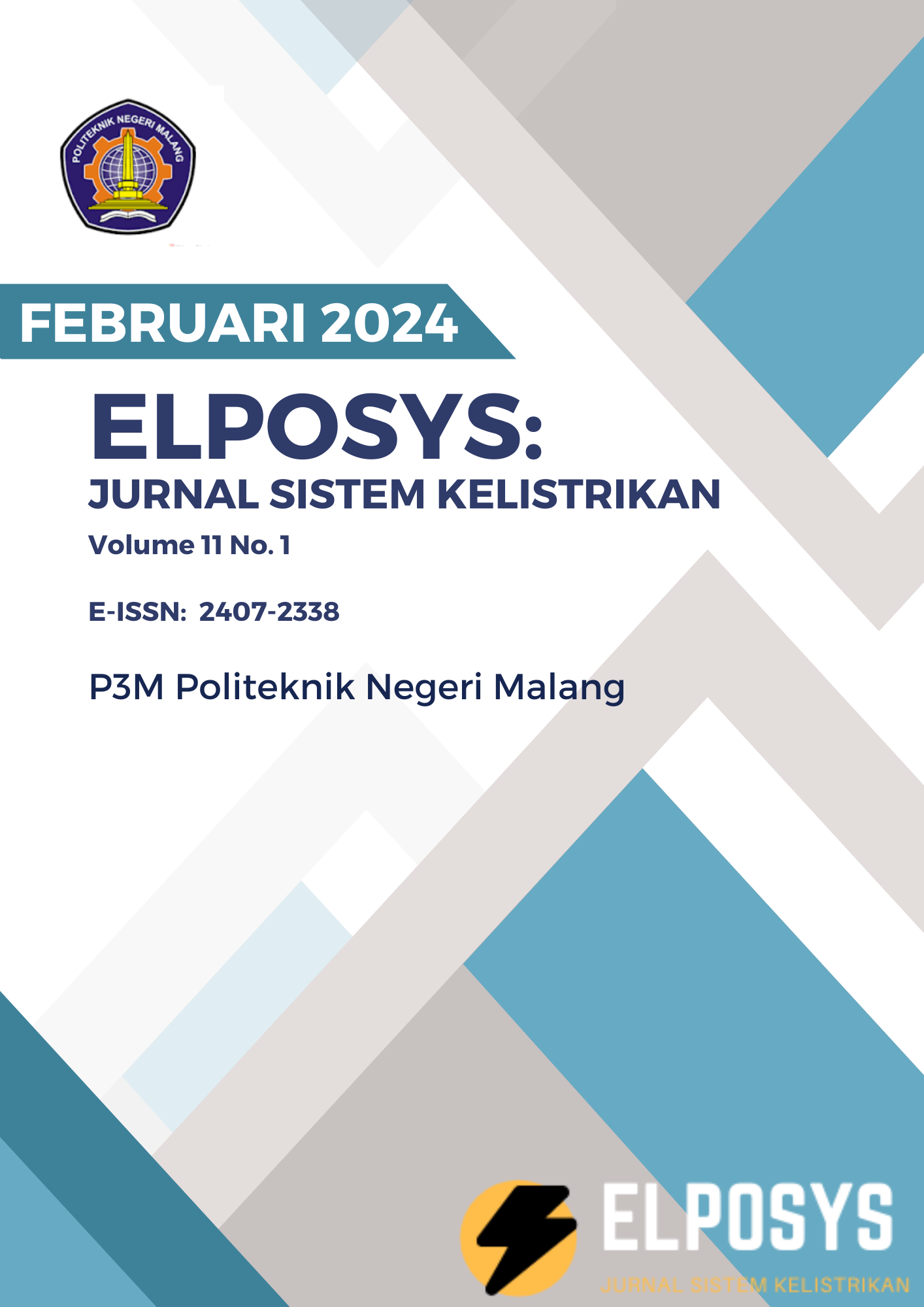Implementasi Sistem Monitoring Alat Pengering Biji Kopi Berbasis IoT (Internet of Things)
DOI:
https://doi.org/10.33795/elposys.v11i1.4964Keywords:
Coffee Bean Dryer, Coffee Bean Drying Methods, Energy Consumption, IoT, TemperatureAbstract
Indonesia holds the third position in global coffee bean supply, with a 3.3% increase in demand in 2021 according to ICO data. In line with ICO Resolution 407, coffee bean quality must be high, indicated by a 12.5% moisture content through drying processes. Mechanical drying is faster than traditional methods, thus becoming the focus of this research. This study implements an IoT-based monitoring system for coffee bean drying equipment. The aim is to create and implement a monitoring system for temperature (0°C - 70°C) and electrical energy consumption (kWh) in coffee bean drying, displayed on the ThingSpeak dashboard. Test results show that the temperature monitoring system using DHT22 sensors at the inlet and outlet of the rotary dryer tube has an average error of 2.1%. The energy monitoring system using PZEM-004T has a 0% energy measurement error. These results indicate a reliable monitoring system that enables remote monitoring via the internet. Furthermore, the study tests manual (on/off) and fuzzy logic control methods to achieve 12% moisture content in coffee beans. The fuzzy logic control method demonstrates better temperature stability and 11.2% cost savings in operational expenses. This research benefits coffee farmers by facilitating efficient monitoring of the bean drying process, and recommends the use of the fuzzy logic control method for stable temperature and lower operational costs.
References
ICO, “Coffee Market Report December 2022,” 2022.
H. Kusumo, “‘Standar Nasional Indonesia : Biji kopi ; Biji kakao ; dan Rumput laut SNI Biji kopi,’” Badan Standarisasi Nasional, Jakarta, pp. 1–60, 2017.
P. Ghosh and N. Venkatachalapathy, “Processing and Drying of Coffee - A review,” Int. J. Eng. Res. Technol., vol. 3, no. 12, pp. 784–794, 2014.
F. O. da Costa, T. F. Alvarenga, T. V. C. de Mesquita, and I. Petri Júnior, “Hybrid drying of pulped arabica coffee cherry beans (Coffea arabica L. cv. Catuai) using a hexagonal microwave dryer designed by numerical simulations,” J. Food Process Eng., vol. 44, no. 5, 2021, doi: 10.1111/jfpe.13666.
D. Santoso and S. Egra, “‘Pengaruh Metode Pengeringan Terhadap Karakteristik dan Sifat Organoleptik Biji Kopi Arabika ( Coffeae Arabica) Dan Biji Kopi Robusta (Coffeae Cannephora),’” Rona Tek. Pertan., vol. 11, no. 2, pp. 50–56, 2018.
W. Dong et al., “Comparative evaluation of the volatile profiles and taste properties of roasted coffee beans as affected by drying method and detected by electronic nose, electronic tongue, and HS-SPME-GC-MS,” Food Chem., vol. 272, pp. 723–731, 2019, doi: 10.1016/j.foodchem.2018.08.068.
T. N. Sandeep, B. B. Channabasamma, T. N. Gopinandhan, and J. S. Nagaraja, “The effect of drying temperature on cup quality of coffee subjected to mechanical drying,” J. Plant. Crop., vol. 49, no. 1, pp. 35–41, 2021, doi: 10.25081/jpc.2021.v49.i1.7059.
S. Yuliati et al., “‘Unjuk Kerja Rotary Dryer Pada Proses Pengeringan Biji Kopi,’” J. Kinet., vol. 9, no. 03, pp. 38–42, 2018.
M. Hasan, M. M. Islam, M. I. I. Zarif, and M. M. A. Hashem, “Attack and anomaly detection in IoT sensors in IoT sites using machine learning approaches,” Internet of Things (Netherlands), vol. 7, p. 100059, 2019, doi: 10.1016/j.iot.2019.100059.
T. Lin, H. Rivano, and F. Le Mouel, “A Survey of Smart Parking Solutions,” IEEE Transactions on Intelligent Transportation Systems, vol. 18, no. 12. pp. 3229–3253, 2017. doi: 10.1109/TITS.2017.2685143.
A. R. Al-Ali, I. A. Zualkernan, M. Rashid, R. Gupta, and M. Alikarar, “A smart home energy management system using IoT and big data analytics approach,” IEEE Transactions on Consumer Electronics, vol. 63, no. 4. pp. 426–434, 2017. doi: 10.1109/TCE.2017.015014.
B. Chen, J. Wan, L. Shu, P. Li, M. Mukherjee, and B. Yin, “Smart Factory of Industry 4.0: Key Technologies, Application Case, and Challenges,” IEEE Access, vol. 6, pp. 6505–6519, 2017, doi: 10.1109/ACCESS.2017.2783682.
Y. Xu, J. Shaull, T. Bavar, and L. Tan, “Smart Coffee Roaster Design with Connected Devices,” 2022 IEEE Int. Conf. Consum. Electron. ICCE-Asia 2022, 2018, doi: 10.1109/ICCE.2018.8326177.
A. Nurbaeti, M. Kusumawardani, and H. Darmono, “‘Rancang Bangun Alat Pengering Biji Kopi Berbasis Internet Of Things,’” J. Jartel J. Jar. Telekomun., vol. 11, no. 2, pp. 74–80, 2021, doi: 10.33795/jartel.v11i2.60.
Y. Saleem, N. Crespi, M. H. Rehmani, and R. Copeland, “Internet of Things-Aided Smart Grid: Technologies, Architectures, Applications, Prototypes, and Future Research Directions,” IEEE Access, vol. 7, pp. 62962–63003, 2019, doi: 10.1109/ACCESS.2019.2913984.
S. Dhingra, R. B. Madda, A. H. Gandomi, R. Patan, and M. Daneshmand, “Internet of things mobile-air pollution monitoring system (IoT-Mobair),” IEEE Internet Things J., vol. 6, no. 3, pp. 5577–5584, 2019, doi: 10.1109/JIOT.2019.2903821.
M. Forcan and M. Maksimović, “Cloud-Fog-based approach for Smart Grid monitoring,” Simul. Model. Pract. Theory, vol. 101, no. June, p. 101988, 2020, doi: 10.1016/j.simpat.2019.101988.
X. Hu, H. Yuan, C. Zou, Z. Li, and L. Zhang, “Co-Estimation of State of Charge and State of Health for Lithium-Ion Batteries Based on Fractional-Order Calculus,” IEEE Trans. Veh. Technol., vol. 67, no. 11, pp. 10319–10329, 2018, doi: 10.1109/TVT.2018.2865664.
R. Hidayat, I. Made, A. Nrartha, I. Bagus, and F. Citarsa, “RANCANG BANGUN SMART kWh METER 3 FASE DENGAN KOMUNIKASI SMS GATEWAY Design Of 3 Phase Smart kWh Meter Using SMS Gateway Communication,” vol. 7, no. 2, pp. 140–148, 2020.
Downloads
Published
How to Cite
Issue
Section
License
Copyright (c) 2024 Elposys: Jurnal Sistem Kelistrikan

This work is licensed under a Creative Commons Attribution-NonCommercial 4.0 International License.








